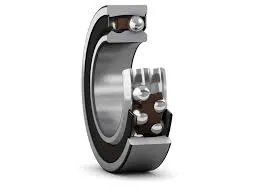
Oct . 20, 2024 06:59 Back to list
parts of a tapered roller bearing
Understanding the Parts of a Tapered Roller Bearing
Tapered roller bearings are an essential component in many machines and vehicles, providing support for axial and radial loads while ensuring minimal friction. These bearings are designed to handle heavy loads while maintaining high speeds, making them ideal for applications in automotive, aerospace, and industrial machinery. Understanding the various parts of a tapered roller bearing is crucial for engineers, technicians, and anyone involved in equipment maintenance and design.
Key Components
A tapered roller bearing consists of several key components, each playing a vital role in its functionality
1. Inner Ring The inner ring, also known as the cone, is a crucial part of the bearing. It is designed to fit tightly onto the shaft and typically includes a series of tapered roller tracks. The inner ring not only supports the rollers but also provides the load-carrying capacity needed for heavy axial and radial forces.
2. Outer Ring The outer ring, or cup, encases the tapered rollers and provides structural support for the bearing assembly. The raceway on the outer ring is also tapered, allowing for improved load distribution and alignment with the inner ring. This design enables the bearing to accommodate simultaneous axial and radial loads effectively.
3. Tapered Rollers These are the rolling elements of the bearing, shaped like a truncated cone. The tapered design allows the rollers to accommodate both axial and radial loads effectively. The angle of taper ensures that the rollers maintain contact with both the inner and outer races, distributing the load evenly and minimizing wear and tear.
parts of a tapered roller bearing

4. Cage (Separator) The cage, sometimes referred to as the separator, is a component that keeps the rollers evenly spaced. It prevents the rollers from colliding with one another, reducing friction and wear. The cage can be made from various materials, including steel, plastic, or brass, depending on the bearing's intended application and the operational environment.
5. Lubrication While not a physical part of the assembly, lubrication is critical for the functioning of tapered roller bearings. Grease or oil is used to reduce friction between the rollers and raceways, preventing wear and overheating. Proper lubrication extends the lifespan of the bearing and ensures smooth and efficient operation.
Design Features and Applications
Tapered roller bearings are designed to meet specific load and speed requirements. The angle of the taper and the size of the rollers can be adjusted to optimize performance for different applications. This versatility allows them to be used in various settings, from heavy machinery and conveyor systems to automotive wheel hubs and landing gear in aircraft.
One of the distinguishing features of tapered roller bearings is their ability to accommodate shaft misalignment. The tapered design allows for some angular movement, which helps to reduce stress and prevent premature failure. Additionally, these bearings are often found in configurations that allow for easy replacement and maintenance, a crucial aspect in industrial settings where downtime can be costly.
Conclusion
In summary, the tapered roller bearing is an intricate assembly composed of several essential parts—inner ring, outer ring, tapered rollers, and a cage—each contributing to its performance. Understanding these components and their functions is vital for optimizing their use in various applications. With their unique design and capabilities, tapered roller bearings stand out as reliable solutions for handling complex load conditions in many mechanical systems. Proper maintenance and lubrication further enhance their efficiency, making them a foundational element in modern engineering and machinery.
Latest news
-
Grooved Ball Bearing Design and Functionality
NewsJun.04,2025
-
Concrete Mixer Bearing Load Capacity Testing
NewsJun.04,2025
-
6004 Bearing Dimensions in Robotic Joint Designs
NewsJun.04,2025
-
Advantages of Single-Row Deep Groove Ball Bearings
NewsJun.04,2025
-
Applications of Deep Groove Ball Bearings in Automotive Systems
NewsJun.04,2025
-
Innovations in Bearing Pressing Machine Design
NewsJun.04,2025
